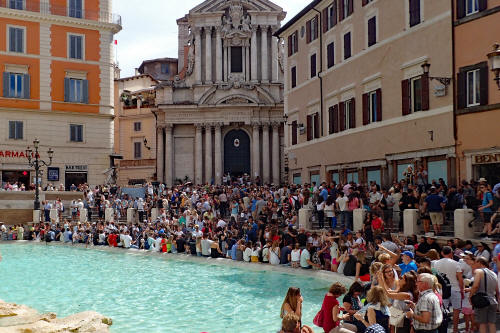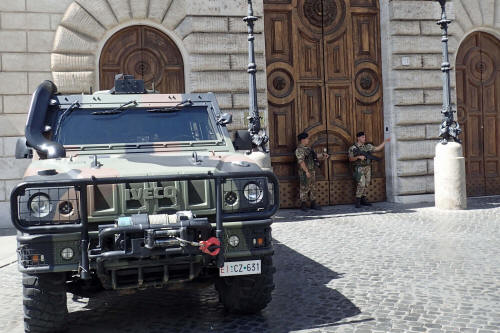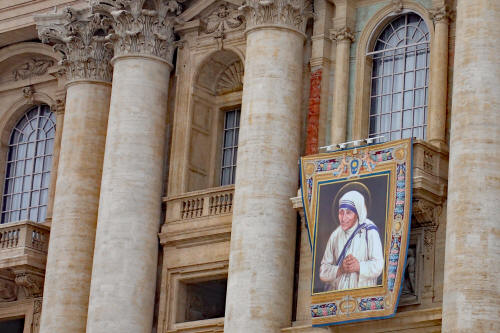|

We had
spent considerable time in Rome (Roma) years
earlier. On our excursions from the port at Civittavecchia, we
used our time to revisit some of our favorite places.
They were considerably more crowded than when we were
last there, and had more
security in place. See also
European Excursions: Rome.
|
|
|

The Roman Forum,
the heart of ancient Rome, a sprawling district of temples,
government buildings, markets and public spaces, was the
scene for religious and secular ceremonies and spectacles.
|

The iconic Colosseum, a symbol of Roman power, was constructed
over 9 years by 60,000 Jewish slaves. During its use for
gladiatorial fights, over 400,000 people and a million wild
animals lost their lives.
|
|

The Victor Emmanuel II
Monument rises above Piazza Venezzia and affords a wonderful
view of the city.
|

The
butterfly-shaped Spanish Steps, the widest stairway in
Europe, climb a steep slope between the Piazza di Spagna and
Piazza Trinità dei Monti.
|
|

We were amused by the
huge crowds at the Tivoli Fountain, who were throwing coins in
to the water to ensure a return to Rome. |

Piazza Navona,
Rome's largest and most beautiful piazza, has three
fountains, an obelisk, a cathedral and an array of Baroque
palaces. It is filled with vendors, musicians, artists and
tourists.
|
|

Villa Borghese
is a large landscaped garden in central Rome. There is a
boating lake, a zoo, a replica of the Globe theatre
and villas scattered throughout the garden which house
museums, including the spectacular Galleria Borghese.
|

We noticed a
significant military and police presence on every street and
near every attraction.
|
|

Campo dei Fiori is the
only piazza that does not have a church. It hosts a daily street
market and is a lively area of cafes and pubs.
|

Largo di Torre Argentina is a square
with the ruins of 4 Roman Republican temples and the remains
of Pompey's Theatre. It is believed to be the place where
Julius Caesar was killed.
|
The entire city is an
art gallery. There are 900 churches, each with their own
collections, 93 fountains, 23 towers, 18 obelisks, numerous
aqueducts, bridges and triumphal arches, and thousands of
statues.
|
|

Vatican City,
an independent city-state is the headquarters of the Roman
Catholic Church. Its St. Peter's Square and Basilica,
Sistine Chapel and Vatican museums are a treasure-trove of
art and architecture.
|

We happened to be
there when Mother Teresa was being canonized and clergy and
worshippers from
around the world were there to honor her.
|
|

The Interior of St.
Peters is overwhelmingly immense, richly decorated with
Baroque stuccoes, mosaics and statues, featuring artwork by
Michelangelo, Bernini, Giotti, Raphael and Canova.
(isogood, wikimedia commons) |

Michelangelo's
La
Pieta was created in 1499 when he was only 24 years old, and is
the only piece that has his signature.
|